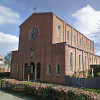Organ 2
Pipes
Alfred Davies was called in again. He had made a name for himself buying domestic organs from grand houses and re-homing them in churches. The Aolean Company had specialised in providing such instruments – for instance, the Barrett family had one in their home in Kingsthorpe (the building that later became the prep school for Notre Dame convent and then St David’s School). This is now in Christchurch on Wellingborough Road. However, it was more usual for Davies to store the components of the instruments he bought and then re-assemble them using parts from several different original instruments. Such was the case for the organ he installed at St Gregory’s, making use of the space provided by the architect for the purpose.
Trouble
The organ had done well, but after 30 years, was needing attention. However, more seriously, it was not adequate for the needs of the church, so that, even if all the repair work were to be done, we would still have an instrument which did not completely meet our needs.
The most obvious shortcoming was simply the volume of sound it could produce. It sometimes happened that the congregation drowned the organ! A further lack was in the tonal variety – there were only six sets of pipes, which was a severe limitation.
A variety of faults were developing with the present organ, such that parts of it were ceasing to work. The swell box action had been giving trouble over some years, and then part of the pedal section failed.
Because the work of rebuilding is highly labour-intensive, the cost of the necessary repair would be considerable. It was therefore sensible to think of a replacement.
Pipes or Chips
One option would be to buy an electronic instrument. They have improved beyond all recognition in the past fifty years and the best are very good; but remain an imitation of the genuine pipe instrument. A quality pipe organ should last at least a generation before requiring major attention. On the other hand, electronic instruments are usually cheaper, but possibly would last less long.
Just as in the 1970s there were country house organs available, today there are many church organs looking for new homes. Many of them are of mediocre quality, and will end up on the scrap-heap. But amongst them are a small number of truly great instruments. Their greatness is not necessarily related to their size; rather to the quality of the manufacture and voicing of the pipes.
We were fortunate, thanks to Dr John Rowntree, the Diocesan Organ Advisor, to find a genuinely great instrument which would cost no more to install than a really good electronic organ.
